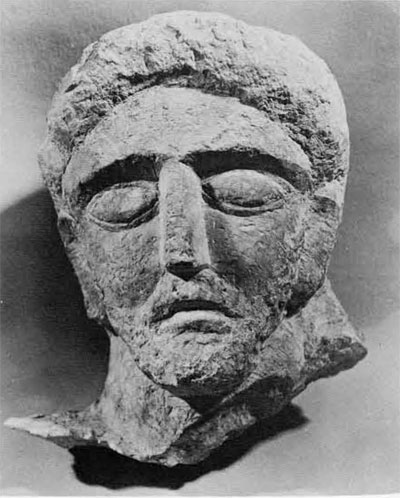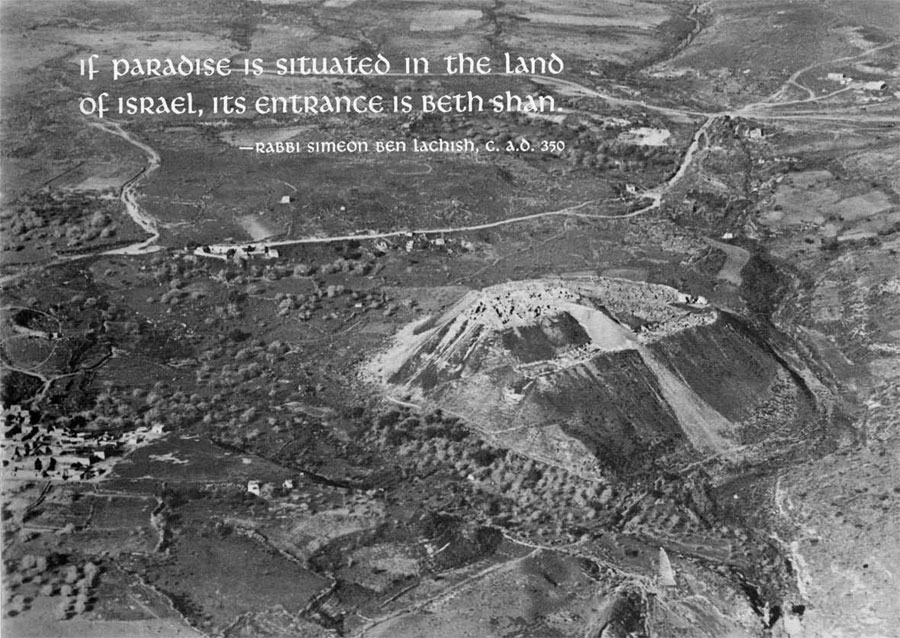
“If paradise is situated in the land of Israel, its entrance is Beth Shan.”
The Biblical Book of Samuel tells us that the bodies of Saul and his sons were exposed by the Philistines on the walls of Beth Shan–one of the greatest and most powerful cities of ancient Palestine.
Over three thousand years later and more than three thousand miles away, remains of that very city, including masses of pottery and small objects from the ruins of its houses, and photographs, drawings and plans of its structural remains, are being “re-excavated” in Philadelphia. For three decades the depression of the thirties and the war of the forties have prevented this wealth of materials, uncovered in ten campaign seasons by the University Museum, from telling their full story. Now, hopefully, with a wealth of new comparative materials at hand from post-War excavations in the Near East, the objects of pre-War date are being dusted off and given their chance to add to the fascinating history of Palestine.
Formally known as the University Museum Palestine Expedition, the Beth Shan excavation of the twenties was the result of a deliberate forward-looking policy. This aimed at extending the scope of the Museum’s work from Egypt into the relatively unknown area of Palestine as soon after World War I as possible.

Clarence Fisher, then Curator of the Egyptian Section, and Dr. G. B. Gordon, Director of the Museum, made a brief tour through Palestine in the spring of 1919, and with the flair for the site so characteristic of Fisher, unhesitatingly chose Beisan, to use the modern Arab name for the town.
The entire Beisan area, including the “tell,” or mound composed of the successive cities which rose here over a period of more than fifty centuries, had been the private property of the Sultan. Here, according to one (unauthenticated) source, the Sultan was in the habit of sending his exiles. But because of its royal ownership “it fulfilled all the conditions of an ideal site, the dream of the archaeologist,” according to Fisher. “There were no modern buildings on its summit, not even the inevitable Sheikh’s tomb or Moslem cemetery that interferes with the complete exploration of so many Palestinian sites.”
In spite of the fact that malaria was rife at Beisan, Fisher immediately staked a claim. In May, 1921, he received the sixth excavation permit issued by the new Department of Antiquities of the British Mandate government, which at the end of World War I replaced the Ottoman regime in Palestine proper.
The original scheme seems to have been to strip the entire tell down to bedrock; and the five uppermost strata were removed completely. First there came the scrappy remains of an early Arab occupation; then a Byzantine stratum with the ruins of the unique round church which crowned the summit during Beth Shan’s flowering in the Early Christian period. Below the church were the remains of a Graeco-Roman temple. This in turn lay over a gateway of masonry style today associated with buildings of the Hebrew monarchy, and preceding the gateway complex were remains of the latest Canaanite occupation.
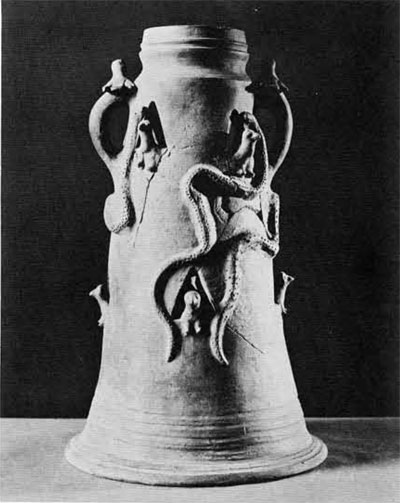
Museum Object Number(s): 29-103-830
Below these completely cleared strata, a large area of each of strata VI-X was excavated, yielding a number of temples and the only Egyptian fortification of the Empire period yet identified anywhere in western Asia. In 1933, the work was ended with a deep sounding to bedrock which produced a series of stratified Early Bronze and Chalcolithic levels. From pits cut in the bedrock came shreds of what is now known as “Jericho Pottery Neolithic B” ware, or ware closely allied to it. At that time no one imagined that this might date from the fifth millennium B.C.
Aside from the excavation on the great tell, approximately one thousand burials in a cemetery on the hill across the River Jalud were also cleared. Most of these graces yielded important objects from the Graeco-Roman period, but a few produced some of the very first archaeological evidence of the Biblical Philistines!
At the time the excavations were in progress it was the Egyptian monuments and the spectacular series of Canaanite temples which won fame for Beth Shan, even in competition with such outstanding contemporary excavations as the Royal Cemetery at Ur and the tomb of Tut-Ankh-Amon. While most of the spectacular items have been dealt with, the bulk of the material still awaits interpretation and publication. Both in turn await funds.
Even so, a small beginning has been made during the past year, using the Markoe Fellowship, in the job of organizing and re-evaluating that part of the collection stored in the University Museum. This initial phase of study is now well under way and has produced a number of important new problems in interpretation.
One fascinating possibility suggested by the preliminary “re-excavation” survey is that an Israelite king may have reconditioned parts of an Egyptian temple complex in erecting the royal storehouses of Beth Shan implied in I Kings, IV!
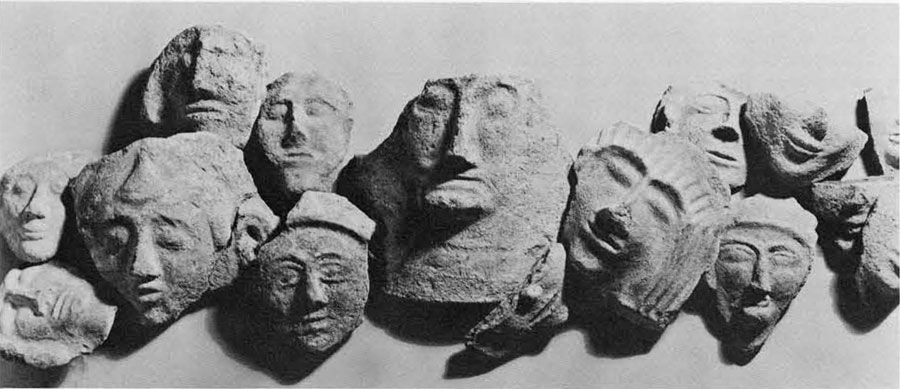
As it happened, the stratum representing Israelits occupation was at the time of the excavations somewhat neglected. This was partly because the Israelite buildings were badly cut by the foundations of the heavy Classical buildings overlying them, partly because of a change of directorship just at this point, and partly because the pottery of the period was then little known. However, it is obvious from the recent study that the archaeological record can supplement the Scriptures’ scattered references to Israelits activities at Beisan. How long the Hebrew Monarchy retained this geographically critical site guarding the road to Damascus and David’s other Syrian possessions is, for example, a much debated question which could be answered at least in part.
Only slightly less important is the question of the Philistines who for a time vied with the Israelites for possession of Beth Shan. It may be that the strange objects buried with their dead here at Beisan will yield clues enabling us to trace this enigmatic people back to its homeland somewhere in the eastern Mediterranean.
In many ways, Beth Shan has already made major contributions to the background of the Bible. The elucidation of Canaanite religion, for example, which is hinted at in such strong terms in the Bible, but so vaguely described, has always been a strong motive for Palestinian excavation. Yet few, if any, bona fide temples had been found before 1925 when the first incredible cult objects began turning up at Beth Shan. Again, by the best of luck, Alan Rowe and G.M. FitzGerald (who took over from Fisher when the latter left to direct the excavation of Megiddo) had chosen to concentrate the work in levels V-X in what proved to have been a sacred area for the three or four centuries immediately preceding the Israelite occupation. From here came not one but six successive temples. with evidence of an astonishing serpent cult.
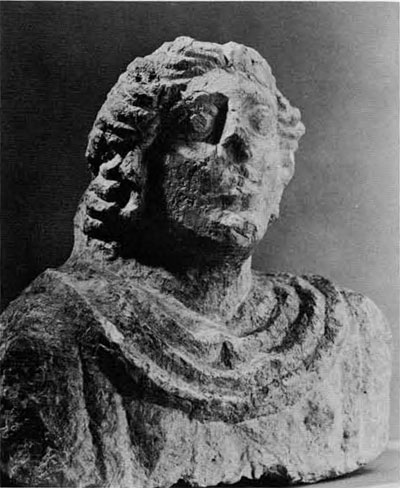
Museum Object Number(s): 29-107-918
Associated with the temples were Egyptian monuments consisting of stone-cut inscriptions of Seti I and Ramsses II, a statue of Ramsses III, and a number of votive dedications made by Egyptian officials to Canaanite gods. The royal inscriptions, or stelae, detailing military operations in the Beisan area by the two most important 19th dynasty pharaohs were an important addition to Egyptian documentary history.
From the viewpoint of Palestinian archaeology, and therefore of the Bible, even though they slightly precede it in point of time, the stelae were of unique significance and remain so. Their significance lies in the fact that Palestine has ever been so poor a country that few monumental inscriptions occur, and although its people could certainly write, they seem most often to have done so on papyrus. This survives in the dry climate of Egypt, but not in the relative dampness of Palestine. We are thus deprived of such valuable minutiae as merchants’ dockets and tax receipts, all likely to provide dating evidence for associated objects and structures.
This lack of written sources for years made Palestinian chronology very difficulty. A fairly precise method of ceramic analysis has now been developed by which dates can be satisfactorily determined, but epigraphic evidence naturally is heartily welcomed for the cross check it provides. Hence the heavy basalt stelae from Beisan are almost worth their weight in gold, as their presence makes it possible to date precisely so many objects from Beisan, and, by comparison, objects from many other sites. It is most unfortunate that the depression made impossible the publication of any of the pottery found during the last five excavation seasons, except for a preliminary report on the very early wares of the deep sounding of 1933.
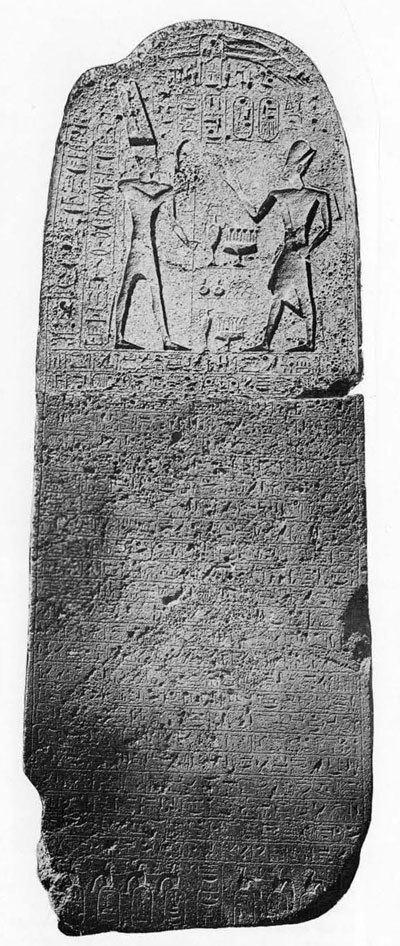
Museum Object Number(s): 29-107-958
Beth Shan appears on the conquest lists of the pharaohs mentioned above. The claim of Ramesses III has been doubted, however, as it can be shown that he copied the campaign lists of a predecessor. Some scholars, in any case, suggest that he could never have exerted effective control of so distant a part of western Asia. Beisan, however, has produced a statue of this Ramesses and his cartouche on an important building inscription. Also in Level VI, covering his reign early in the twelfth century B.C., some trouble was taken to stamp the “Egyptian way” on the site. For example, T-shaped stone doorsills with their complementary inscribed door jambs, otherwise unknown in Palestine, occur in a number of buildings assigned to Level VI by the excavators.
Beth Shan also occurs on the conquest lists of Sheshonk, who raided Palestine in the fifth year of Rehoboam, and of Thutmose III, who, in the fifteenth century B.C., conquered the Syro-Palestinian littoral as far north as the Euphrates. The basement “re-excavation” has yielded absolutely no information about Sheshonk’s raid, and this is one of the things it is hoped a more detailed study will produce.
The strangest problem raised by the recent survey, however, occurs regarding the town captured by Thutmose. Whether any actual occupation level on the excavated area of the tell can be dated to his reign is doubtful. As has long been recognized, the original dating of the Beth Shan strata was too high, and the so-called Thutmose III level (IX) in reality represents occupation considerably later than the reign of this king. Below IX, Level X appears to date to a fairly early phase of the Middle Bronze Age. It cannot therefore be later than about 1600 B.C. and is probably earlier. While this suggests a gap in occupation, a very little pottery occurs, in a single tomb and in the fill separating Levels IX and X, to suggest continuity. This is the sort of situation which only further pick and spade excavation may be able to settle definitely. While a complete study of the material now at the Museum may also change the picture, on present evidence it appears that the Beth Shan conquered by Thutmose III was at best one of the smallest settlements in the history of the site.
If little has been said about Graeco-Roman Beisan–or Scythopolis as it was known when it was the chief city of the New Testament Decapolis–this is because, like many other towns at this time, it moved from its mound to the plain below. Here it ultimately achieved a circumvallation over two miles around and fine civic buildings, the ruins of which are still visible. Thus, except as represented in the tombs and summit sanctuaries, Scythopolis lay beyond the scope of the Museum excavation. The tombs themselves, however, were very rich in burials of this period. They have produced an enormous quantity of Roman glass and some include a charmingly crude bust of the deceased, so ingenuous as to be true folk art. Similar busts are known elsewhere near Beisan, but not in other parts of Palestine.

The problem of the Scyths, for whom Classical writers tell us Beth Shan was renamed Scythopolis, remains. The Scyths were the enfants terribles of the middle of the first millennium B.C. who galloped across the Near East from Assyria to the borders of Egypt, looting and raiding and besieging cities. The artifact usually attributed to them is a three-dimensional, triangular arrowhead. Not one of these occurs at Beisan. Does this mean that the city was never besieged by the Scyths, or that this type or arrowhead is incorrectly associated with them?
Is is no small thing to have conceived and carried to a successful conclusion the excavation of such a physically great and archaeologically important site as Beth Shan, and the University Museum can be proud of the foresight which achieved this. Palestine was as archaeologically unexplored in the twenties as is Iran today, where the current Museum excavations are doing much to fill in a gap in knowledge. It is a sobering thought that an excavation of the magnitude of the Beth Shan dig probably could not be repeated today, costs being what they now are.
Though less dramatic, the Beisan results are in every way as brilliant as those of the contemporary excavation of Ur, sponsored by the University Museum in conjunction with the British Museum. What remains is to round off the Beisan achievement in the manner due its significance by tying up loose ends with proper publication, so that these important findings are available to all scholars–whether or not it is possible for them to undertake their own private “excavations” in the Museum basement.

